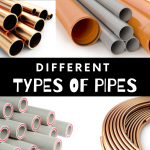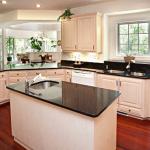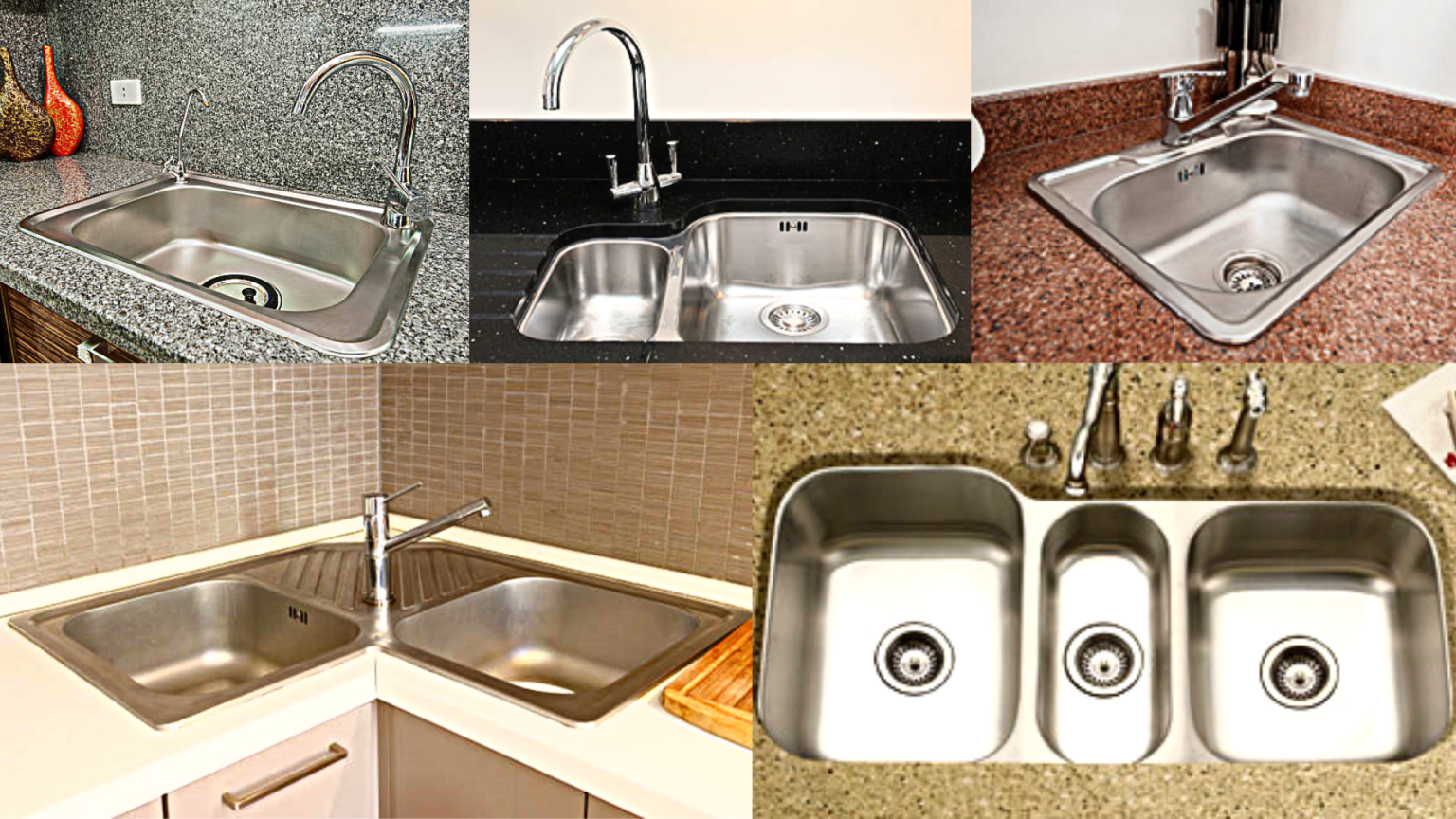
KITCHEN SINKS: TYPES | BASE ON INSTALLATION, BASIN CONFIGURATION AND MATERIALS
One of the most difficult tasks when designing or remodeling a kitchen is choosing the right types of sinks for the space. Since the sink is one of the busiest areas in the kitchen, finding the best types of sinks is important. Kitchen sinks are also an important focal point and help to set the tone of the kitchen.
Kitchen sink options differ in terms of mounting style, appearance, basin configuration, and material used in their construction. To assist you in selecting the sink that best suits your needs, we will discuss the available options.
Types of Kitchen Sinks
Your kitchen sink should be both aesthetically pleasing and functional. There are many different types, sizes, shapes, and styles of kitchen sinks. They are classified based on their installation process, materials, and other factors.
Some options are functional, while others are just aesthetic. Different types of kitchen sinks have their own set of benefits, but the style you choose will be influenced by the sink’s size, installation, and use.
Let’s take a look at the various types of kitchen sinks.
Base On Installation
Top-Mount, Drop-In, or Self-Rimming Sink
The most popular kind of sink is a top-mount model, also called a drop-in or self-rimmed sink. In this instance, a sink was inserted into a counterpart hole with little to no support beneath it. This sink is inexpensive and can be installed on most countertops.
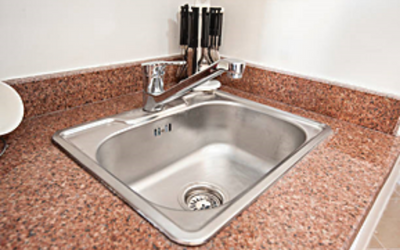
Top-mount sinks are typically made of durable stainless steel, but they are also available in porcelain or cast iron. Kitchen sinks that are top-mounted lack the sleek appearance of sinks that are under-mounted and gradually accumulate dirt.
Under mount sink
Undermount sinks are mounted on a frame that completely supports them and are installed beneath the countertop. They are ideal for solid surfaces such as granite. Since undermount sinks are made of sturdy materials, laminate and tile are not options.
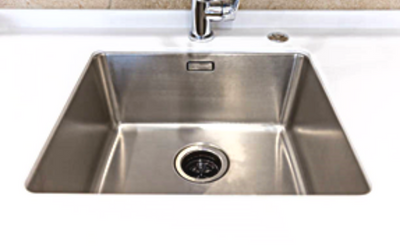
They have a sleek, modern appearance and make a fantastic addition to any house. Cleaning up spills and messes is also simplified with undermount sinks because you can simply swipe everything into the sink.
They combine functionality, convenience, and a clean appearance, making this one of the simplest options for installation. In terms of structural integrity, these sinks have far too many weaknesses. The most common options are quartz and granite.
Flush Mount Sink
A flush-mount sink, also called a tiled-edge sink, sits flush with the countertop and is supported by the base cabinets. It is made from the same material as the countertop and sink basin, resulting in a seamless and aesthetically pleasing unit.
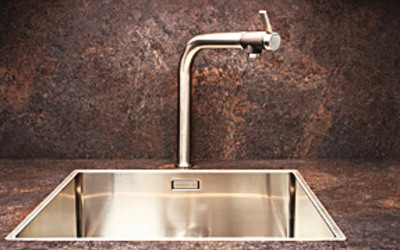
Because the edges are completely seamless, it’s difficult to tell they’re two separate pieces of material. Separate pieces are made for the countertop and sink, which are then put together during installation. The visual effects are comparable to those of an undermount sink, but the installation method is different.
To ensure a strong connection between the sink and the countertop and to maintain a uniform, smooth design, a grout line should be used. The grout line can be finished in a color that properly complements both components.
Farmhouse sink or Apron Sink
Farmhouse sinks, also known as apron sinks, are large single-basin sinks distinguished by a front wall that serves as both the front of the sink and the front of the counter.
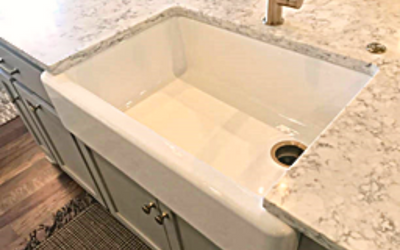
The most common type of installation is at the sink level and integrated into the counters. However, apron sinks can also be positioned “country style,” without counters, on top of a cabinet or a freestanding table that is fixed to the wall.
Integrated sink
Since integrated sinks are made with the same material as the countertop, they have a more seamless appearance than under-mount or flush-mount sinks. The countertops and sinks are actually one piece that was fused together in the factory.
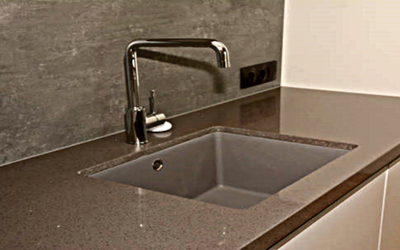
An integrated kitchen sink is perfect for a modern kitchen because of its sleek and high-end appearance. The most popular materials for these sinks are ceramic or natural stone. They can be expensive if made of stone, but they may be less expensive if the sink and countertop are made of ceramic.
Corner Sink
A corner sink is any type of sink that is placed in one of your countertop’s corners. Corner sinks are excellent for small spaces and are also a good option for kitchens that require a unique design.
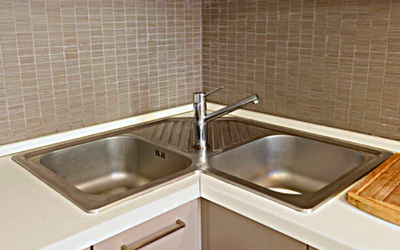
To save space, corner sinks like bar sinks are perfect for kitchen counters that are U or L shaped. These sinks allow you to turn an unused corner of your kitchen into a functional and busy space.
It can help you keep your kitchen clean and clutter-free. This sink completes the design of your kitchen and has a stunning appearance.
Also Read: Epoxy Flooring | Foam Concrete | Concrete Stairs Reinforcement Details |Box Culvert Reinforcement Layout | Types of Fitting in Plumbing | Steel Deck Installation and Construction
Base on Basin Configuration
Sink basins come in a variety of styles. Despite the fact that busy kitchens might need more sinks, single and double sinks are the most common.
Single Basin Kitchen Sink
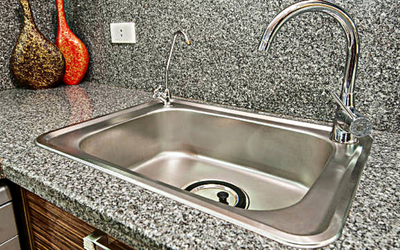
Single-basin kitchen sinks come in a variety of sizes and styles. They have a single small or large basin with no division for other kitchen tasks like drying or food preparation.
Advantages
- Large Tasks – Using a single large basin makes it simpler to wash large pots, pans, and dishes.
- Appearance – Single basin sinks have a timeless, classic look that complements traditional kitchen styles.
Disadvantage
- Rinsing – There is no designated area for dishwashing or food preparation.
Double Basin Kitchen Sink
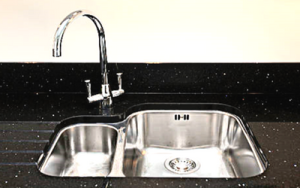
The double basin sink is the most common type of sink. They may have two basins separated by a ridge the height of the sink’s edges. They can also have lower dividers that rise only halfway up the basin sides.
Advantages
- Separate Compartment – Having two basins enables you to divide tasks like washing, drying, and food preparation.
- Single Basin Appearance – Low-divide kitchen sink styles give the appearance of a single basin but allow for the separation of basins.
Disadvantage
- Size – Most double basin sinks are large and occupy more space in the kitchen.
Multiple Basin Kitchen Sinks
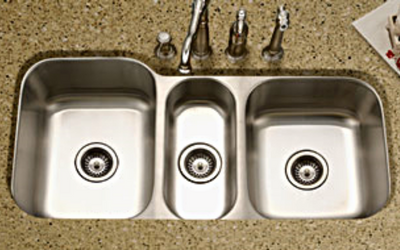
Multiple-basin sinks have three or more basins. These frequently feature basins of varying sizes, with the smallest in the center. These are large sink designs that are most effective in kitchens with spacious countertops.
Advantage
- Task flexibility is made possible by the numerous basins.
Disadvantage
- Size – Triple basin sinks are substantial and occupy a sizable amount of countertop space.
Drain board sink
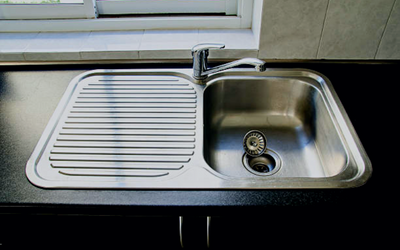
An apron is commonly attached to one or both sides of this sink. The apron on a drain board sink overlaps part of the counter and is intended to drain water. For draining dishes, drain board sinks are ideal. For those who frequently wash their dishes by hand, this type is the most useful.
Base on Materials
The material that sink fabricators use to make the sink is one of the most crucial considerations when choosing a kitchen sink. This will have an impact on the sink’s longevity, cost, and style.
Stainless Steel Kitchen Sink
It is the most popular choice for a sink material that is more expensive than porcelain but less expensive than solid surface or granite sinks. They are available in both top and under-mount configurations.
This sink is simple to install, clean, and maintain, and it bends well with most countertop surfaces. Stainless steel sinks are suitable for almost all kitchens.
This material has a number of disadvantages, including a tendency to make a lot of noise when washing dishes, a lack of uniqueness when compared to other materials, and a propensity to dent and scratch easily.
Copper Kitchen Sink
Although it is more expensive, copper is still a great option. It requires very little maintenance, is extremely durable, and doesn’t tarnish or rust.
Copper has antimicrobial properties that destroy viruses and germs. In addition to many other kitchen designs, an industrial kitchen would look fantastic with this sink.
Cast Iron Kitchen Sink
Kitchen sinks made of cast iron typically have a porcelain enamel coating on them. They are simple to clean and have a smooth, glossy finish that conceals water spots and streaks.
Cast-iron sinks have many benefits, including longevity, heat and scratch resistance, and monoporousness. Due to its weight, it is more expensive than other sink material options and more challenging to install.
Granite Kitchen Sink
Granite kitchen sinks can withstand high temperatures and are simple to clean. They are long-lasting and stain- and scratch-resistant. Granite sinks are available in single or double bowl configurations and do not lose their luster easily.
Due to the weight of granite sinks, your existing cabinet and countertop may need to be reinforced in order to support the sink, which would undoubtedly increase the cost of installation.
Fireclay Kitchen Sink
Fireclay is a substance created by combining clay and glaze at extremely high temperatures. Durability, a non-porous surface, resistance to acids and scratches, and chip resistance are some of the benefits. There are some drawbacks, such as a high price tag, a lack of color variation, and stain susceptibility.
Additionally, these sinks are quite big. Similar to cast-iron sinks, professional installation with additional support is recommended. They are more costly than other types of kitchen sinks.
Quartz Kitchen Sink
A quartz sink is frequently intended to serve as the focal point of your kitchen. Quartz is a type of hard natural stone that resembles crystals in that it is colorless and translucent.
Quartz sinks are produced using a combination of mineral quartz, colored quartz, and acrylic to produce a solid and stylish structure.
For kitchen sinks, quartz is a material that can be used instead of granite. Quartz sinks are hygienic, scratch- and stain-resistant. The only disadvantage is that it has low heat resistance.
Porcelain Kitchen Sink
A variety of kitchen fixtures have been made of porcelain, a material that is a combination of clay, glass, and metal. Due to its fragility, porcelain is also less frequently used in kitchen sinks than other materials.
It has a lot of drawbacks, including a significant tendency to fade and chip over time. However, it is available in a variety of colors and can be among the most attractive sinks.
Acrylic Kitchen Sink
This polycarbonate-based material is one of the most appealing choices. The material can be molded into a variety of shapes and colors, and the finished item is highly repairable.
It is simpler to install or repair a lightweight acrylic sink than an enamel, steel, or composite one. A soft cloth can be used to clean up scuffs and stains.
It is one of the best sink materials for sound absorption because, in comparison to other materials, it is very soft. It does not, however, last as long as most materials.
Additionally, it does not stand up well to petroleum-based products like paint. The surface of the sink may be scratched by steel wool and other abrasive items.
Composite Kitchen Sink
Composite kitchen sinks are made of a variety of materials, most frequently a combination of crushed quartz, stone dust, and engineered acrylic resins. Composite sinks are also becoming more popular.
Some composite kitchen sinks have a smooth surface, while others feel a little bit rougher. These sinks are scratch, stain, and chip resistant.



